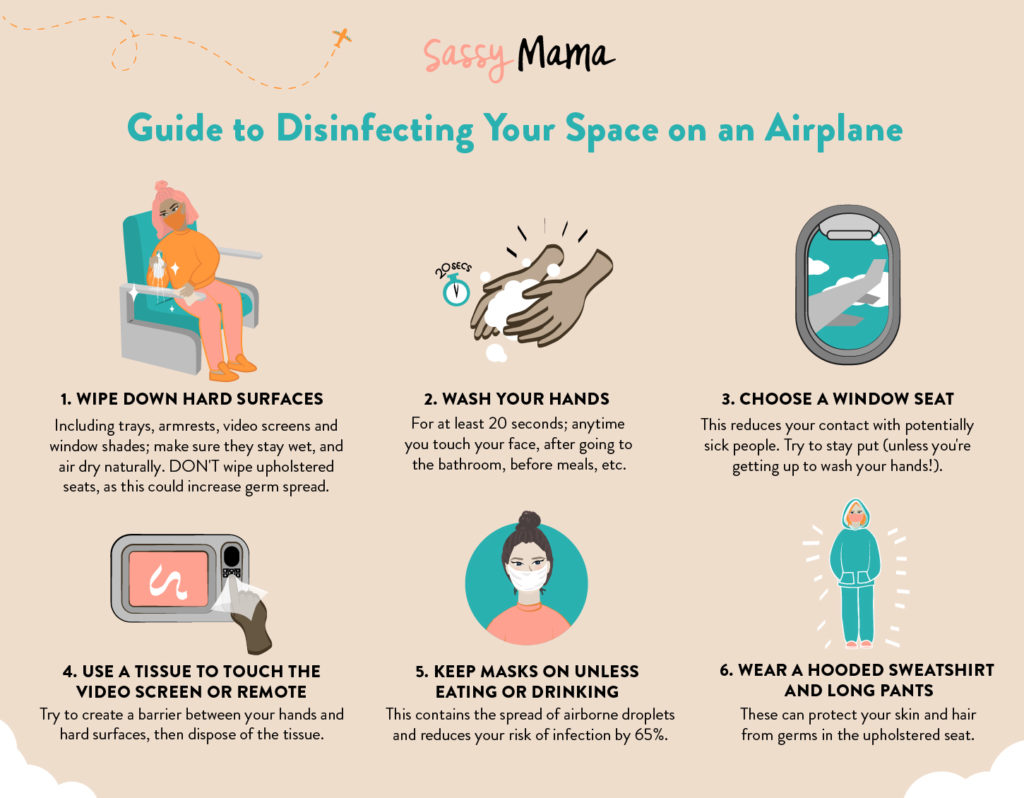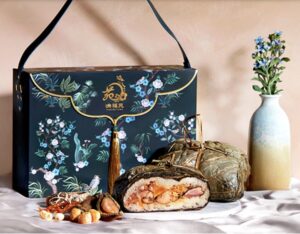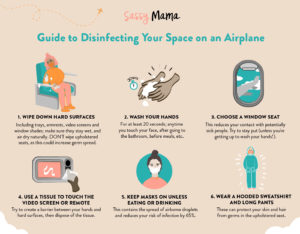
In the wake of Covid, flying has slowed considerably, but if you MUST travel, here’s how to disinfect your airplane seat and stay healthy while flying
Since March 2020, most of us in Singapore have been grounded from air travel. But what do you do if you are able to go away for the summer holidays (perhaps to see family abroad), have other essential travel, such as a family emergency, or are repatriating? We’ve put together six essential tips for flying during the pandemic – from how to properly disinfect your airplane seat to what you should wear to protect yourself.
1. Wash Your Hands and Avoid Touching Your Face (duh)
We’ve made this pretty clear by now, but washing your hands with soap is absolutely THE most effective thing you can do to prevent the spread of Coronavirus. This is a good explanation of how soap works to kill germs on a molecular level – unsurprisingly if you’re on a plane and touching lots of surfaces and foreign objects, or blowing your nose, or wiping your eyes, wash your hands each and every time. And try to use your elbow or a tissue to open the bathroom door afterwards!

2. Choose a Window Seat
As cited in the New York Times, a flu study done by Emory University found that passengers were less likely to transmit droplet-spread infections to others who were sitting at least two seats away – i.e. you’re less likely to catch something from that sneezing person who’s walking up and down the aisle if you’re sitting by the window. The study also found that 80% of people sitting in aisle seats get up during a flight (and are thus exposed to more people), compared to just 40% of people in window seats. We suggest getting up only to wash your hands, stretch your legs, and use the toilet!
3. Wipe Down Hard Surfaces and Leather Seats
Take a cue from Naomi Campbell and thoroughly wipe down all the hard surfaces around your seat before sitting down. We know that Coronavirus is transmitted via droplets, and that some of those can last for days on hard surfaces. So wipe down everything in sight: tray tables, armrests, your window and window shade (and you should be sitting by the window!), your video screen and the remote. The same goes for non-porous surfaces like leather/pleather seats and seat back pockets – but NOT for upholstered seats, which could a) get wet (not pleasant for you to sit on!) and b) stay damp, which would actually lead to the spread of germs. This is where creating a natural barrier can come in handy (more on that below).
Anti-bacterial wipes like these (which are 70% alcohol) should do the trick. Hopefully in the coming months wipes from popular brands like Lysol and Clorox will be available again, but in a pinch you could also try using a spray hand sanitizer with high-alcohol content and a clean, disposable cloth. Whatever you use, be sure to let the surface dry naturally – usually for around 30 seconds to a minute – to ensure efficacy.
Read more: How to make your own Hand Sanitizer
4. Use a tissue to touch the video screen or remote
Anything you can do to create a physical barrier is great. As Professor Vicki Stover Hertzberg of Emory told the New York Times, using a tissue or paper towel ensures there’s a barrier between your hands and a surface that might have droplets. Whether or not you use a tissue (and then dispose of it), try to use hand sanitizer right after just in case.
5. Wear a mask. Full stop.
When this all began, experts around the world advised that face masks were unnecessary, and could even spread the virus due to their discomfort (which might cause people to touch their faces more). But the World Health Organisation changed its tune on June 5 and is now advising people to don masks whenever they are in close proximity to others. It’s undeniable: masks can help to contain the spread of airborne viral droplets. And the longer the pandemic has gone on, the more clear it has become that masks stop the spread of the virus — reducing your personal risk of contracting it by about 65%!
Dr. Amy Price, a Stanford scientist whose research impacted the WHO’s decision to change its guidelines, explains the rationale thusly:
“Many people argue that cloth masks can’t be effective because they can’t filter out viral particles, which are extremely tiny. But, most of these particles leave the mouth and nose in much larger droplets that become smaller through evaporation as they move away from the body. Trapping droplets with the mask means not nearly as many viral particles escape. So, when all parties in a gathering are wearing well-constructed, well-fitting masks, it provides an extra layer of safety for everyone. If two people are wearing masks, the viral particles can travel about 5 feet away from each individual. When an infected person is not wearing a mask, those particles can float through the air 30 feet or more and stay alive for up to 30 hours.”
Do bear in you mind you should only wear a mask for so long before swapping in a new one, as masks can allow viruses to be transmitted around and even through them, and once they become moist encourage the growth of viruses and bacteria. See the MOH’s recommendations for more tips about properly wearing masks.
Read more: Where to buy reusable face masks in Singapore
6. Wear a Hooded Sweatshirt and Long Pants
In this recent article, Dr. Thomas Horowitz in California advocated for wearing a hooded sweatshirt and long pants when flying – particularly if sitting on an upholstered seat that can’t easily be wiped down. The reason? All sorts of nasty germs (even like lice, eeew!) can live in that fabric, and can even get into your hair (hence the protection of the hoodie). We know it’s not the chicest look, but at least you’ll be comfortable – and clean!
In addition to all of the above tips, it’s essential to stay hydrated and try to eat healthy, wholesome meals and snacks to boost immunity both before and during the flight (it can be a challenge, we know!). All of these are of course just additional precautions on top of what airlines already do, and we’re blessed to live in the region that’s home to the cleanest airlines in the world. We hope these tips give you peace of mind, mamas, and wish you safe and healthy travels. Here’s hoping we can all start putting these tips to use again soon!






 View All
View All




 View All
View All









 View All
View All





